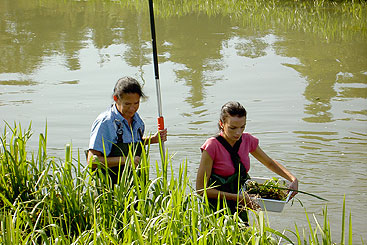Working together to share knowledge

Working together to share knowledge
Eight Danube countries participated in a specialised course to learn methods of analysing biological quality elements that would be compliant with the EU Water Framework Directive. Sharing this information ensures that all countries across the basin can reach the goals of the directive.

Participants took samples from two rivers, Kamenny potok and Cierna voda, and tried to identify as many species as possible from the sampling stretches.
The Danube River Basin Management Plan is a milestone toward meeting the goals of the EU Water Framework Directive (WFD). However, coordinating a variety of countries across the basin is a challenge and serious gaps exist in the data, hindering progress. Recently, several Danube countries came together to fill in some of those gaps.
A specially focused course on WFDcomplaint methods for analysis of biological quality elements was organised for non-EU countries to address gaps in the assessment of the ecological status. The course was held under the framework of the ICPDR and was supported by an EU grant.
The three-day course was organised by the Slovak Water Management Society of the Water Research Institute of Bratislava, and was held on 26–28 September in the small town of Senec, 25 kilometres from Bratislava.
Experts in the field. Participating trainees came from Bosnia and Herzegovina, Moldova, Montenegro, Serbia and Ukraine, with two experts on water flora from each country. Trainers Peter Pfister and Karin Pall from Austria, Gorazd Urbanic from Slovenia and Dana Fidlerova from Slovakia presented the intercalibration process of biological methods for the European level. The experts have all been involved in developing WFD-compliant methods at the national level.
In the classroom and by the riverbank. The course programme was divided into two parts. First the theory was presented, with general information on phytobenthos, including sampling, preparing samples, basic taxonomy, evaluating data and methods of assessing different types of rivers in Austria, Slovenia and Slovakia based on phytobenthos. Presenters also shared knowledge on macrophytes, including surveying, estimating biomass, preparing samples, basic taxonomy as well as the development of national methods for assessing different types of rivers based on macrophytes.
For the second part of the programme, the field survey, two types of rivers were selected. The first, Kamenny potok, is a small mountain river in the Carpathian eco-region. The second, Cierna voda, is a middle-sized lowland river in the Pannonian ecoregion. Participants took samples of both communities and tried to identify as many species as possible from the sampling stretches.
The rest of the course focused on assessing the field survey data. Participants calculated the relevant national indices and evaluated the results based on Austrian, Slovenian and Slovakian methods of phytobenthos and macrophytes. This comparison allowed for a small intercalibration of the three national methods. At the end of the course, participants and trainers discussed way to apply the approaches and methods learned.





